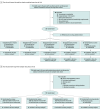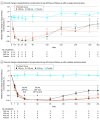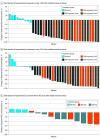Single Ascending and Multiple-Dose Trial of Zerlasiran, a Short Interfering RNA Targeting Lipoprotein(a): A Randomized Clinical Trial
- PMID: 38587822
- PMCID: PMC11002768
- DOI: 10.1001/jama.2024.4504
Single Ascending and Multiple-Dose Trial of Zerlasiran, a Short Interfering RNA Targeting Lipoprotein(a): A Randomized Clinical Trial
Abstract
Importance: Lipoprotein(a) is a causal risk factor for atherosclerotic cardiovascular disease (ASCVD) and calcific aortic stenosis, with no pharmacological treatments approved by regulatory authorities.
Objectives: To assess the safety and tolerability of zerlasiran, a short interfering RNA targeting hepatic synthesis of apolipoprotein(a), and effects on serum concentrations of lipoprotein(a).
Design, setting, and participants: Single- and multiple-dose study in healthy participants and patients with stable ASCVD, respectively, with lipoprotein(a) serum concentrations greater than 150 nmol/L, conducted at 7 research sites in the US, the Netherlands, UK, and Australia between November 18, 2020, and February 8, 2023, with last follow-up on August 23, 2023.
Interventions: Participants were randomized to receive (1) a single subcutaneous dose of placebo (n = 8), zerlasiran 300 mg (n = 6) or 600 mg (n = 6); or (2) 2 doses of placebo (n = 9), zerlasiran 200 mg (n = 9) at a 4-week interval or 300 mg (n = 9) or 450 mg (n = 9) at an 8-week interval.
Main outcomes measures: The primary outcome was safety and tolerability. Secondary outcomes included serum levels of zerlasiran and effects on lipoprotein(a) serum concentrations.
Results: Among 37 patients in the multiple-dose group (mean age, 56 [SD, 10.4] years; 15 [42%] women), 36 completed the trial. Among 14 participants with extended follow-up after single doses, 13 completed the trial. There were no serious adverse events. Median baseline lipoprotein(a) concentrations in the multiple-dose group were 288 (IQR, 199-352) nmol/L. Median changes in lipoprotein(a) concentration at 365 days after single doses were 14% (IQR, 13% to 15%) for the placebo group, -30% (IQR, -51% to -18%) for the 300 mg of zerlasiran group, and -29% (IQR, -39% to -7%) for the 600-mg dose group. After 2 doses, maximal median changes in lipoprotein(a) concentration were 19 (IQR, -17 to 28) nmol/L for the placebo group, -258 (IQR, -289 to -188) nmol/L for the 200 mg of zerlasiran group, -310 (IQR, -368 to -274) nmol/L for the 300-mg dose group, and -242 (IQR, -343 to -182) nmol/L for the 450-mg dose group, with maximal median percent change of 7% (IQR, -4% to 21%), -97% (IQR, -98% to -95%), -98% (IQR, -99% to -97%), and -99% (IQR, -99% to -98%), respectively, attenuating to 0.3% (IQR, -2% to 21%), -60% (IQR, -71% to -40%), -90% (IQR, -91% to -74%), and -89% (IQR, -91% to -76%) 201 days after administration.
Conclusions: Zerlasiran was well tolerated and reduced lipoprotein(a) concentrations with infrequent administration.
Trial registration: ClinicalTrials.gov Identifier: NCT04606602.
Conflict of interest statement
Figures



References
-
- Burgess S, Ference BA, Staley JR, et al. ; European Prospective Investigation Into Cancer and Nutrition–Cardiovascular Disease (EPIC-CVD) Consortium . Association of LPA variants with risk of coronary disease and the implications for lipoprotein(a)-lowering therapies: a mendelian randomization analysis. JAMA Cardiol. 2018;3(7):619-627. doi:10.1001/jamacardio.2018.1470 - DOI - PMC - PubMed
Publication types
MeSH terms
Substances
Associated data
LinkOut - more resources
Full Text Sources
Medical

